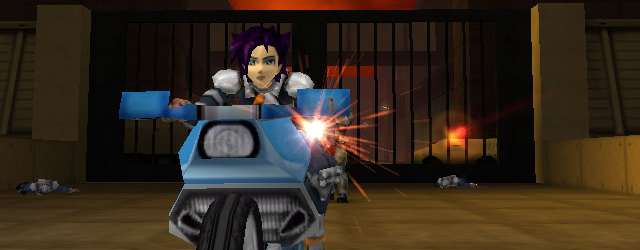
Haha! It works! Thank you, Oni Anniversary Edition, thank you. The game works flawlessly – sound, music, comedy graphics, decent resolutions. I even adventurously turned the visual quality from the suggested “medium” to “high”. I know, crazy. One generic tutorial later I’m thrown into a plot that leaves me thinking I should have read the manual again. It’s not complicated but I’ve no idea who any of the people or companies are. Heigh ho.
So how does it play, and how does that stand up to memory and nostalgia? Very well so far, in all honesty. Read on.
Colour-coded beatings
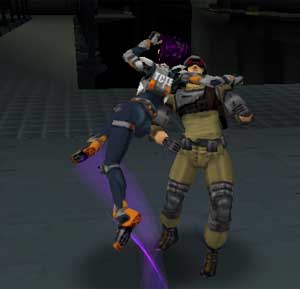 I remember the game being simple to play – but not boringly so. There’s only two attack buttons: left click for punch, right click for kick. Combine that with jumping, crouching and movement and you’ve got the basics of a fighting game in there. Add in a very competent combo system and you’ve got a very enjoyable brawler with a surprising amount of depth. One advantage of the Anniversary Edition is that it unlocks all the combos from the start rather than doling them out as the game goes on. On the plus side that means muscle-memory dredged up from the bubbling swamp of my brain is actually being useful, on the other hand I’m still too fresh to the game to have nailed down the sharp timing of the combos I really want to use. Even so, occasionally pulling off the Rising Fury Punch is still satisfying all these years later.
I remember the game being simple to play – but not boringly so. There’s only two attack buttons: left click for punch, right click for kick. Combine that with jumping, crouching and movement and you’ve got the basics of a fighting game in there. Add in a very competent combo system and you’ve got a very enjoyable brawler with a surprising amount of depth. One advantage of the Anniversary Edition is that it unlocks all the combos from the start rather than doling them out as the game goes on. On the plus side that means muscle-memory dredged up from the bubbling swamp of my brain is actually being useful, on the other hand I’m still too fresh to the game to have nailed down the sharp timing of the combos I really want to use. Even so, occasionally pulling off the Rising Fury Punch is still satisfying all these years later.
I was honestly surprised at how familiar some things seemed. The same go-to moves and chains – knock down, stomp, sweep, back off, repeat. Lariat twist, sledgehammer kick, roll free, repeat. This made for a good reintroduction to the game – it was easy without being straightforward and the struggle I feared to get back my old skills (using the word charitably) never materialised. In the two hours I played I died once and that was largely down to my own idiocy. Pro-tip: charging the length of an empty hall at someone firing at you with a machine gun is rarely a good life choice. When you’re carrying a fully-loaded plasma rifle it’s just pitiable. The sneering “You lose!” the soldier gave my perforated body was totally deserved and I didn’t hold it against him.
Blocky fists of fury
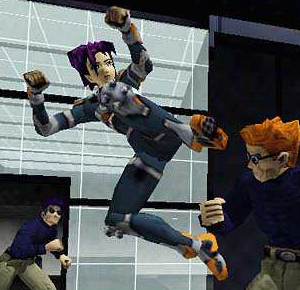 If the game holds up ludically and kinaesthetically (oh yes, I went there) the graphics have aged… not so gracefully. The animation is fine in-game, but in cutscenes characters usually have none of the subtle animations we’ve come to take for granted. Background characters will stand perfectly still, no breathing, no moving. The polygon count is tiny – Konoko has more triangles in her hair than her face, so there’s no facial animation. Remember in Deus Ex how everyone had solid blocks for hands? Yeah, that’s here too. To be fair though most characters justifiably have their hands bunched in fists at all times, Queensberry-style, so that’s not as noticeable as in other games.
If the game holds up ludically and kinaesthetically (oh yes, I went there) the graphics have aged… not so gracefully. The animation is fine in-game, but in cutscenes characters usually have none of the subtle animations we’ve come to take for granted. Background characters will stand perfectly still, no breathing, no moving. The polygon count is tiny – Konoko has more triangles in her hair than her face, so there’s no facial animation. Remember in Deus Ex how everyone had solid blocks for hands? Yeah, that’s here too. To be fair though most characters justifiably have their hands bunched in fists at all times, Queensberry-style, so that’s not as noticeable as in other games.
Overall, the graphics are blocky, the scenery oversized and flat, the environments empty and bare. In the brief moments I was outside I could literally see the edges of the sky box, black lines marking out the limits of the universe. Textures near walls flicker in and out, the camera merrily flies through scenery and seeing corpses lying half-inside walls is common. But all is forgiven, because the animation and movement is as buttery-smooth and fluid as anything that came before or since and in a combat game you can look past the visuals but you can’t ignore the motion. The part of the game that mattered hasn’t aged a day.
Brain in a box
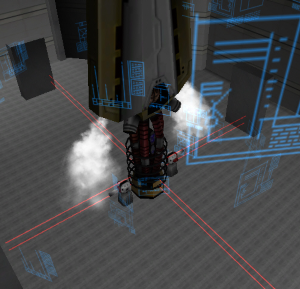 After a couple of levels you hit the game’s first boss fight. Or rather, two boss fights, back to back. On the surface that sounds like an odd idea but it actually worth both from a story and a design perspective.
After a couple of levels you hit the game’s first boss fight. Or rather, two boss fights, back to back. On the surface that sounds like an odd idea but it actually worth both from a story and a design perspective.
The first is a Deadly Brain – a static weapons platform powered by a biological brain, which oddly enough provides the first true laugh of the game. The fight actually involves no combat at all – the brain is surrounded by a series of consoles you have to reach and interact with. Flick the switch on all of them and the brain moves to a more difficult configuration – while you’re running around it has a series of lasers rotating around and if one of these touches you the guns open up. Machine gun fire starts to chip away at your health and makes reaching the next piece of cover just tricky enough that you risk being caught by the slow energy balls that pack a serious wallop. Best no to touch the lasers then.
The first fight tests you on how much you’ve picked up of the movement mechanics so far – it requires you to sprint, jump and slide with a reasonable degree of precision and timing. Unless you’re careless it’s a simple process but quite a satisfying one. Of course it’s just practise for bigger, badder ones later…
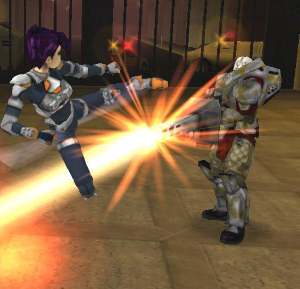 Then you reach the second fight, what might be called the first “real” boss – Barabas. No test of running, jumping or climbing trees here. Barabas carries a big gun and has special moves all of his own. He can be a tough fight on your first go through, especially since the game resets your inventory between levels – hoarded hypo-sprays and ammo on the last level? Well screw you. It’s just you and him though and if you’ve been paying attention to your blocking and knock-down techniques there’s not much of a trick to defeating him.
Then you reach the second fight, what might be called the first “real” boss – Barabas. No test of running, jumping or climbing trees here. Barabas carries a big gun and has special moves all of his own. He can be a tough fight on your first go through, especially since the game resets your inventory between levels – hoarded hypo-sprays and ammo on the last level? Well screw you. It’s just you and him though and if you’ve been paying attention to your blocking and knock-down techniques there’s not much of a trick to defeating him.
Two consecutive boss fights might seem unfair but I found it to be a smart piece of design. Aside from an opportunity to move a plot on and punctuate levels boss fights are first and foremost a means of testing a player on what they’ve learned so far and rewarding them if they’ve learned well. Having one fight involve brawling and platforming would be, I suspect, an intensely frustrating affair. Splitting them out into two separate and very different encounters solves the issue neatly, while allowing the first to serve as a coda to the level you just did, while the second is a dramatic opening to the next part of the game.
Want biff. Biff now?
I went into this session uncertain of how it would go, not sure if there would be a part 2. I can say now there will be. Yeah, it looks like someone spilled purple all over Half Life and then lost half of the scenery, but it plays just fine. Better than fine – far worse games have come and gone since then. What started as an interesting piece of nostalgia has turned into a genuine desire to finish the game again.
Kudos, Bungie.
